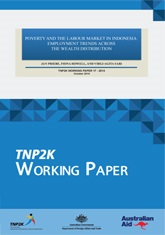Poverty and the Labour Market in Indonesia: Employment Trends across the Wealth Distribution
Working Paper 17
October 2014
Authors: Jan Priebe, Fiona Howell, and Virgi Agita Sari
‘Poverty and the Labour Market in Indonesia: Employment Trends across the Wealth Distribution’, is among Indonesia’s first papers on the relationship between poverty and the labour market. It provides a detailed analysis of employment indicators (labour force participation rates, hours worked, and type and sector of employment) for the period 2000-2012 across the entire wealth distribution, by location, gender and various sociodemographic characteristics.
Despite high economic growth rates, the creation of millions of new jobs, and a strong decrease in poverty rates in recent years, many Indonesians continue to live in poverty even when employed. This paper finds that the poor are as likely as the nonpoor to work, both at the extensive (labour force participation) and at the intensive (number of days and number of hours) margins. The reason for being poor despite being employed is therefore largely driven by other factors.
In terms of household structure, clear evidence exists that the working poor need to share their income with a larger household, including economically nonactive members such as young children and the elderly. The higher dependency ratio contributes to their being/becoming working poor. Significant gender differences exist in the Indonesian labour market. Men show higher labour force participation rates and are more likely to work more hours compared with women. However, no strong gender differences were observed when comparing the working poor with the nonpoor.
The authors observed that the relative share of the rural working poor as a portion of all working poor has increased over time and that the majority of the working poor are employed in the agricultural sector. Furthermore, the working poor are predominantly and increasingly (in relative terms) concentrated in the informal sector of the economy. An important finding concerns the role of education in the likelihood of being poor or nonpoor. Results also suggest that only the attainment of higher secondary and tertiary education seems to increase the likelihood of being meaningfully protected against poverty.
The TNP2K Working Paper Series disseminates the findings of work in progress to encourage discussion and exchange of ideas on poverty, social protection, and development issues.
Support for this publication has been provided by the Australian Government through the Poverty Reduction Support Facility (PRSF).
The findings, interpretations, and conclusions herein are those of the author(s) and do not necessarily reflect the views of the Government of Indonesia or the Government of Australia. You are free to copy, distribute, and transmit this work for noncommercial purposes.
Suggested citation: Priebe, Jan, Fiona Howell, and Virgi Agita Sari. 2014. ‘Poverty and the Labour Market in Indonesia: Employment Trends across the Wealth Distribution’. TNP2K Working Paper 17-2014. Jakarta: Tim Nasional Percepatan Penanggulangan Kemiskinan (TNP2K).
To request copies of the paper or for more information on the paper, please contact the TNP2K Knowledge Management Unit (kmu@tnp2k.go.id). The paper is also available at the TNP2K website (www.tnp2k.go.id).
